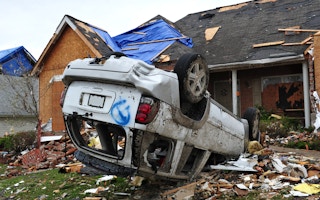In a world where links between countries are bigger and faster than ever, disasters that once might have only had local effects now increasingly have international ramifications, affecting multiple countries, economies, sectors and social systems.
The effects from the tsunami and meltdown of Japan’s Fukushima reactor, for example, had devastating local consequences, but also impacted communities and economies thousands of miles away. In such an interconnected world, with impacts that touch upon all of society, locally and internationally, we need an “all-of-society” and “all-of-the-world” approach.
Cutting risks
While challenging, an increasingly interlinked world also provides unprecedented opportunities to reduce risk. Neighboring countries can now help each other develop the capacity to rapidly respond to disasters. For example, Cuba (in partnership with UNDP) created the Risk Reduction Management Centre (RRMC), a model of risk reduction management that proved so successful countries around the Caribbean requested Cuba and UNDP help them establish their own RRMCs, an expansion that has helped protect an additional 570,000 people. Countries that might have once been at a dire disadvantage from a skills and knowledge perspective now have the ability to draw upon international resources. And the private sector—which operates in perhaps an even more hyper-connected environment than governments—can be called on to provide expertise.
Our goal then, as we move into a new context beyond the 2015 Millennium Development Goals, is to learn how to tap into these areas and to make use of innovative partnerships that draw on specific strengths and address identifiable gaps.
From faster visas to storing food
“
Countries that might have once been at a dire disadvantage from a skills and knowledge perspective now have the ability to draw upon international resources. And the private sector—which operates in perhaps an even more hyper-connected environment than governments—can be called on to provide expertise.
The Get Airports Ready for Disasters (GARD) programme, a joint venture between UNDP and Deutsche Post DHL, is an example of such innovation. The programme joins the logistics expertise of DPDHL with the governance and capacity building experience of UNDP to help targeted countries strengthen airport capacities to manage possible disasters.
From expediting long-visa delays for relief workers to storing temperature-controlled food and medicine, the partnership draws on the strengths of both institutions, combines this with the local knowledge and skills at country level, and addresses an obvious gap in the relief supply chain. The result is better disaster preparedness that incorporates public and private expertise.
For example, GARD implemented a successful program in Manila, Philippines, that caught the attention of officials in other regions of the country. After Typhoon Haiyan struck in 2013, the Cebu Provincial Government and Mactan Cebu International Airport requested training and the airport assessment from GARD (which had previously been successfully implemented in Manila) so that the airport would be better equipped to handle future disasters; the training built up the airport staff’s capacity to efficiently handle a rapid influx of relief goods.
The benefits of GARD are manifold: for the country in question, expertise is built up, with systems put in place that can help reduce the effects of disasters. UNDP’s knowledge is put to good use, which both ensures the quality of its assistance while, in the long run, reducing costs. And for private sector partners, relationships with local partners and businesses are deepened, in addition to the general social good they have a chance to contribute to.
Unfortunately, partnerships like GARD are not easy to find – whether due to bureaucracy in the UN, hesitation from governments or from private sector partners who do not see the advantage. There aren’t nearly as many of these partnerships as there should be.
Positive signs
There are positive signs, however. Already in Indonesia, Uzbekistan and FYR Macedonia, UNDP has signed on with private companies and universities to develop mobile phone apps that instruct people on disasters; and in other areas, UNDP is exploring partnerships to enhance early warning and strengthen data collection.
2015 is an especially important year for disaster risk reduction. The Hyogo Framework for Action (HFA), which was the first global framework to explain, describe and detail the work required to reduce disaster losses, is set to expire. The HFA will be replaced during the World Conference on Disaster Risk Reduction that will take place this March in Sendai, Japan. The new framework will use the lessons learned from the HFA period (2005-2015) to create a new framework to better prevent, mitigate and prepare for disasters.
As the Sendaï conference nears, we would do well to look at programs like GARD, and partnerships with the private sector, as examples of how comprehensive disaster risk reduction must be done. Disasters affect us all, and that means we all have to be involved in preparing for them.
Neil Buhne is director of UNDP’s Geneva Liaison Office. This post is republished form the World Economic Forum blog.











